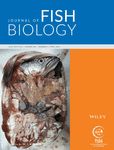Please find all scientific publications of IGB under > scientific publications
For more detailed information please refer to our > library catalogue
21 - 30 of 672 items

May 2025
Nature Ecology & Evolution. - X(2025), XX-XX
Learn from Chinese examples to save endangered sturgeons from hydropower dams
Hong Cao; Liang Zhang; Jörn Gesser; Leonardo Congiu; Xin Gao; Boyd Kynard; Qiwei Wei; Ping Xie

May 2025
Journal of Fish Biology. - XX(202X)X3, XX-XX
Age and growth of the Pacific goliath grouper (Epinephelus quinquefasciatus), the largest bony reef fish of the Tropical Eastern Pacific
Carolina Chong-Montenegro; Matthew T. Craig; Gustavo A. Castellanos-Galindo; Brad Erisman; Peter G. Coulson; Uwe Krumme; Rodrigo Baos; Luis Zapata; Angel Vega; D. Ross Robertson
May 2025
Hydrological Processes. - 39(2025)5, Art. e70141
Storage Dynamics and Groundwater–Surface Water Interactions in a Drought Sensitive Lowland Catchment: Process-Based Modelling as a Learning Tool
Zhengtao Ying; Doerthe Tetzlaff; Jean-Christophe Comte; Songjun Wu; Chris Soulsby
May 2025
Research ideas and outcomes. - 11(2025), Art. e152859
Ecology for a social revolution: Re-defining the role of ecological and environmental science professionals and their responsibilities towards society
Florencia A. Yannelli; Wayne Dawson; Mark van Kleunen; Jonathan M. Jeschke; Tina Heger
May 2025
Journal of Zoology. - XX(202X)XX, XX-XX
Annual variation in riverscape habitat use by a diadromous fish before oceanic migration
R. Futamura; K. Morita; Y. Kanno; A. Terui; A. Okuda; O. Kishida
May 2025
Freshwater Biology. - 70(2025)5, Art. fwb.70023
Using Long-Term Ecological Datasets to Unravel the Impacts of Short-Term Meteorological Disturbances on Phytoplankton Communities
Viet Tran-Khac; Jonathan P. Doubek; Vijay Patil; Jason D. Stockwell; Rita Adrian; Chun-Wei Chang; Gaël Dur; Aleksandra Lewandowska; James A. Rusak; Nico Salmaso; Dietmar Straile; Stephen J. Thackeray; Patrick Venail; Ruchi Bhattacharya; Jennifer Brentrup; Rosalie Bruel; Heidrun Feuchtmayr; Mark O. Gessner; Hans-Peter Grossart; Bastiaan W. Ibelings; Stéphan Jacquet; Sally MacIntyre; Shin-Ichiro S. Matsuzaki; Emily Nodine; Peeter Nõges; Lars Rudstam; Frédéric Soulignac; Piet Verburg; Petr Znachor; Tamar Zohary; Orlane Anneville
May 2025
Biological Conservation. - 308(2025), Art. 111199
A unifying theoretical framework for conservation flagships
Ivan Jarić; Sarah L. Crowley; Jonathan M. Jeschke; Ugo Arbieu; Gabriel Henrique de Oliveira Caetano; Ricardo A. Correia; Arjun Kamdar; Richard J. Ladle; Stefano Mammola; Uri Roll; Diogo Veríssimo
May 2025
Water Research. - 283(2025), Art. 123764
Phytoplankton abundance and methane emissions are minimally impacted by environmentally-relevant glyphosate concentrations in small-scale outdoor mesocosms
Christopher F. Frazier; Ted D. Harris; Tonya DelSontro; Hans-Peter Grossart; Belinda S.M. Sturm; Jalynn M. Murry; Andrew Ising
May 2025
Water Resources Research. - 61(2025)5, Art. e2024WR039042
One-Hundred Fundamental, Open Questions to Integrate Methodological Approaches in Lake Ice Research
Joshua Culpepper; Sapna Sharma; Grant Gunn; Madeline R. Magee; Michael F. Meyer; Eric J. Anderson; Chris Arp; Sarah W. Cooley; Wayana Dolan; Hilary A. Dugan; Claude R. Duguay; Benjamin M. Jones; Georgiy Kirillin; Robert Ladwig; Matti Leppäranta; Di Long; John J. Magnuson; Tamlin Pavelsky; Sebastiano Piccolroaz; Dale M. Robertson; Bethel G. Steele; Manu Tom; Gesa A. Weyhenmeyer; R. Iestyn Woolway; Marguerite A. Xenopoulos; Xiao Yang

May 2025
Ecotoxicology and Environmental Safety. - 297(2025), Art. 118262
Community assembly characteristics of abundant and rare bacterial taxa in water, sediment and riparian soil of Wujiang river, China
Yang Yang; Chen Chen; Hans-Peter Grossart; Yingliang Liu






